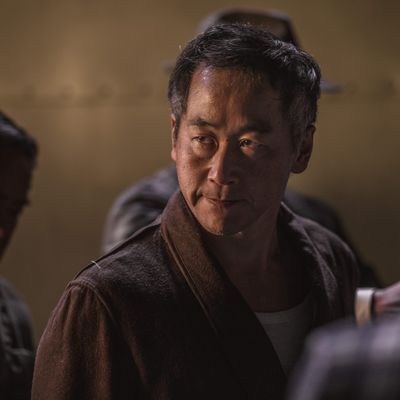
AMC’s The Terror: Infamy, a horror fantasy set against the backdrop of Japanese-American internment, is the kind of story in which metaphors turn literal. Among the most unnerving images is that of a Japanese-American man trapped on a frozen lake, the ice cracking all around him. This character is believed to have named fellow Japanese-Americans as spies to the U.S. Department of Justice, knowing they were innocent, for fear that if he’d told his bosses the truth—he didn’t know any spies—he would lose his job and the trust of the Establishment. His accusers have cracked just enough of the ice to make it impossible for him to move without imperiling himself further. The sight of a man marooned out on a sheet of ice, paralyzed by the fear that any move he makes will be the wrong one, sums up the predicament of many of this anthology series’ characters, who remain estranged from the place they’ve adopted as their homeland and can’t seem to win for losing: If they learn English, adopt local customs, and otherwise attempt to assimilate into the white-dominated mainstream, they’re viewed with suspicion, and if they keep to themselves and try to preserve some semblance of their culture, they’re viewed with even more suspicion.
Fans of the first season of The Terror, which told the story of two doomed British ships exploring the Northwest Passage in the mid-19th century, will be struck by how different Infamy is, not just in subject matter, location, and period but in its horror aesthetic. Season one had a historical-political dimension—it was a story of imperial hubris disguised as scientific curiosity, about Englishmen losing their sense of invincibility one hideous death at a time—but for the most part, it was content to be an exercise in spooky atmosphere and a handsomely annotated list of all the ways the human body can be damaged and destroyed: by disease, drowning, a fall, fire, animal attack, and so on. Season two was co-created by Max Borenstein (the 2014 Godzilla and its sequel) and Alexander Woo (True Blood)—Jewish-American and Chinese-American writers, respectively—and written by a staff that includes Naomi Iizuka, an American playwright of Japanese-Latinx ancestry, and Tony Tost, a Scots-Irish poet from the Ozarks. Its first hour, set in the aftermath of Pearl Harbor, feels more like a dry run for a new season of American Horror Story than a follow-up to the shipboard paranoia of last season, jumping quickly from shock to shock (a gory death, a couple of supernatural-seeming visitations) and presenting so many characters, relationships, and scene-setting details in 52 minutes that it’s hard to keep it all straight.
But then the internment begins, the Japanese-American inhabitants of a Southern California fishing village are relocated to a stable, and Infamy settles into a mournful, empathetic groove, holding the viewer less through supernatural-horror elements than its re-creation of a period of history that TV has rarely touched. Our guide is Chester Nakayama (Derek Mio), an aspiring photojournalist and the son of Japanese immigrants. More than any other major character—save for his -Mexican-American girlfriend, Luz Ojeda (Cristina Rodlo), who works at a Catholic orphanage—Chester is torn between two worlds and uses his provisional connections to power to try to get answers and justice for friends and relatives who are being herded and handled like livestock. “I apologize for the mess,” says Chester’s mother, Asako Nakayama (Naoko Mori), referring to the filthy cell she now calls home—one of many examples of a character clinging to shreds of dignity in a situation that won’t allow that sort of illusion. Parallels to the current crisis at the U.S.-Mexico border are not only inevitable but encouraged, particularly when a soldier confirms that the government is going to imprison children, too, if they have as much as “one drop” of Japanese blood. Star Trek icon George Takei, who was interned himself as a child, is on hand to connect this drama to lived reality.
The upshot is a series that is so mesmerizing when it’s being a stylistically conservative historical drama that when the mandatory inexplicable or ghastly moments arrive (everything from a tea-leaf prophecy by a strangely figurative-seeming character to a blinding reminiscent of a curse from Greek tragedy), they have less impact than the scenes of people trying to live a normal life in completely abnormal circumstances. This is the most radical departure between seasons of a buzzed-about new series since FX’s American Crime Story, which started out by retelling the O. J. Simpson case as a docudrama with elements of satire, then followed it up with an account of the death of Gianni Versace and the life of his killer, told backward à la Memento. Long stretches of this season of The Terror don’t quite work, but you always appreciate the attempt to confront an era that has largely been avoided in American popular culture—one that now comes bubbling up through our collective subconscious like a monster visible beneath layers of ice.
*This article appears in the August 5, 2019, issue of New York Magazine. Subscribe Now!


